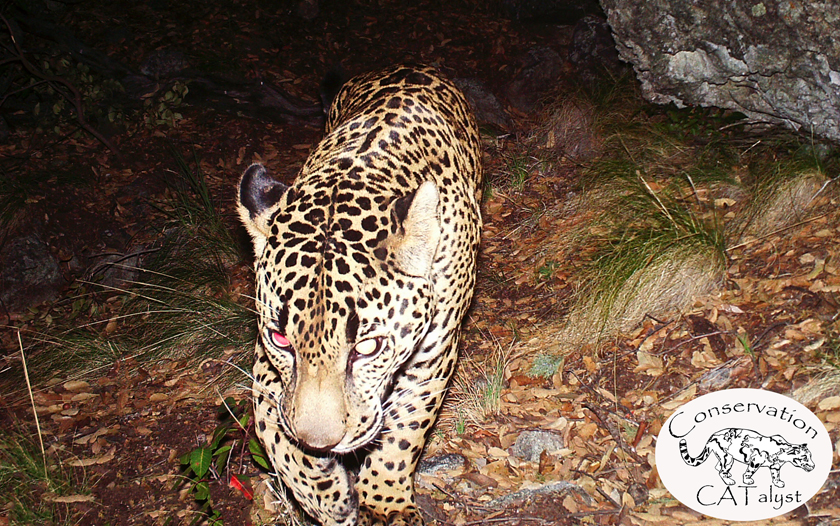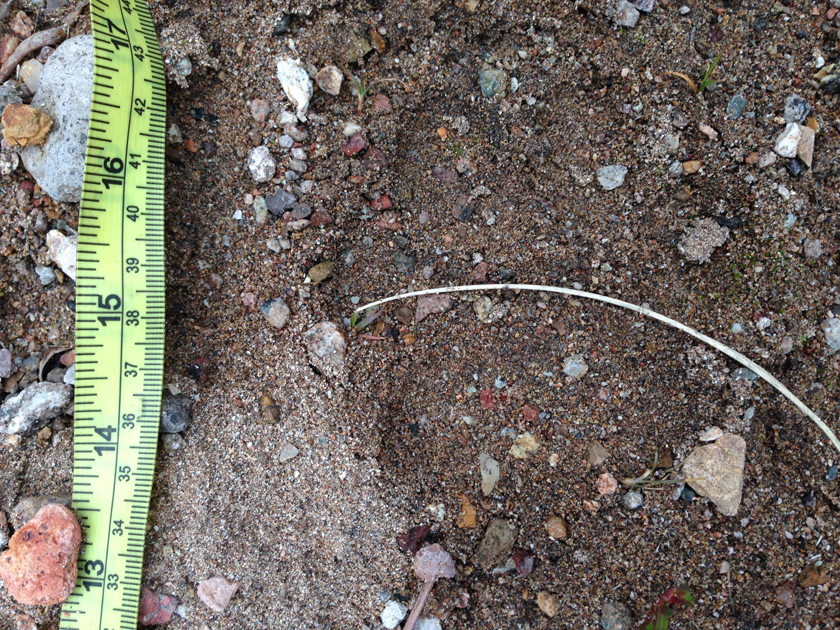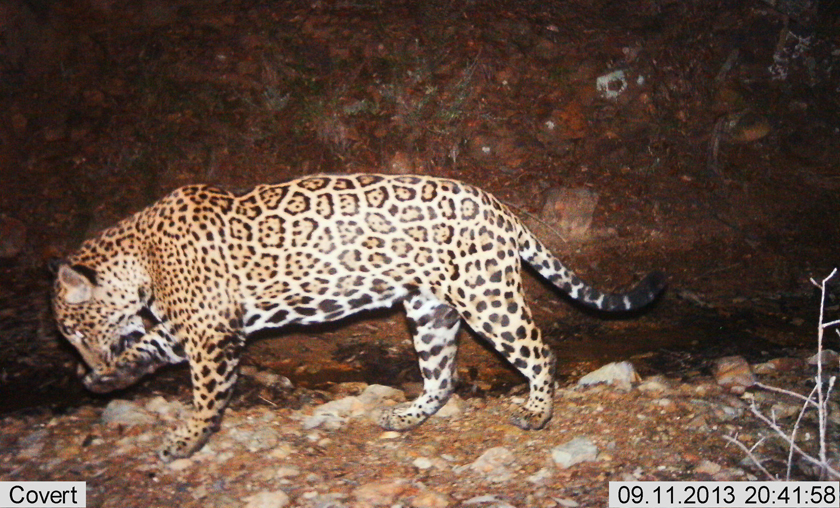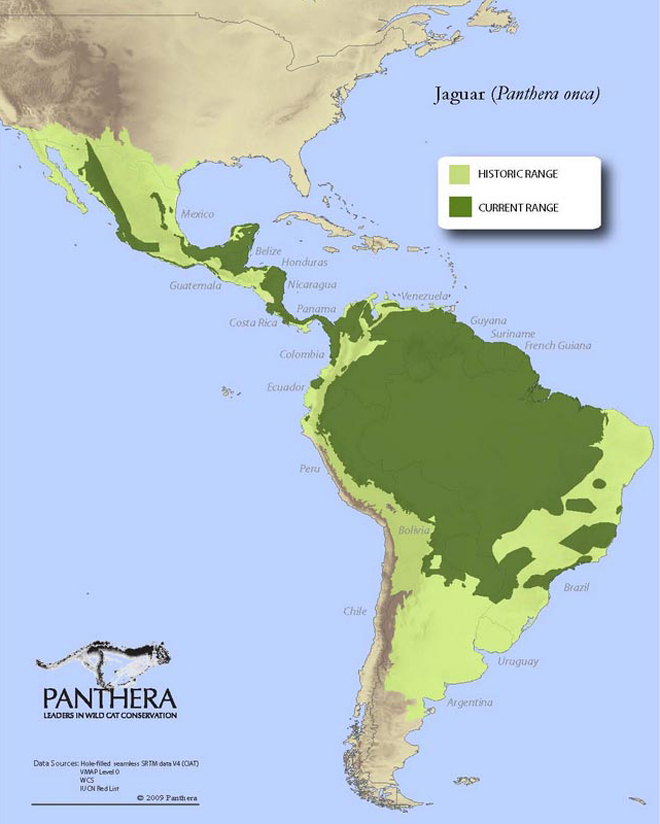El Jefe: The US’s Only Wild Jaguar—Can We Keep Him?
Arizona biologists share the first video images of the only known jaguar in the US in hopes of saving him and his home.
By Vicki Croke

El Jefe, the only known wild jaguar in the United States appears well-fed, confident, and graceful in a recently released video. Photo: Conservation CATalyst.
It’s just-released video, and in it, we get to see for the first time, moving images of the only wild jaguar in the United States.
The footage of “El Jefe†taken by camera traps in the Santa Rita Mountains south of Tucson, Arizona, may just be about 40-seconds long, but it provides an amazing glimpse of an exotic cat big cat in the prime of his life. And it represents years of intensive tracking, camera trapping, and strategizing by conservationists.
The cat is so good at being invisible that the conservationists tracking him, even with the help of a trained dog, have never directly seen him. Still, Aletris Neils, founder and executive director of Conservation CATalyst, says that for her tracking this animal is “like reading a book.â€Â Her group, working with the Center for Biological Diversity—has been following El Jefe for three years. And Neils, a carnivore expert and experienced tracker, has come tantalizingly close.
“There have been times when I’ve been following his tracks…where I’m minutes behind him, I mean, his tracks are so crisp, you can see every single line from his foot, every single crevice in these tracks and I know I’ve been right behind him,†she says, “but we’ve never been fortunate enough to see him.â€
Even without bumping into the spotted cat, she feels like she’s getting to know him. Piecing together a portrait of his personality by the clues he leaves behind.
Up in the Santa Ritas, Neils says, there are also mountain lions, bobcats, and bears. Those animals she finds easy to track. But El Jefe is like—in her words—a “4-by-4†all-terrain vehicle who decides to go wherever he wants and just plows through. She says those who follow his tracks are “torn up and bloodied†by the end of the day.
What she’s been able to see too, with the aid of a scat-sniffing Belgian Malinois named Mayke, and through strategically placed camera traps, is a glimpse of how different cat species here might be leaving messages for each other. The jaguar, a mountain lion, and a bobcat have placed their own deposits on top of the urine or feces left behind by one another.
These are the elements that now help fill out some of the more basic facts about the jaguar that Tucson schoolchildren helped name: who he is and where he came from. Scientists figure that he is most likely a “dispersing male†–that is a young jaguar striking out on is own from his birth area–from the nearest breeding population, which is about 100 miles south in Sonora, Mexico. Northern Mexico is considered the top of jaguar range.
Jaguars can be found from Argentina through Mexico, and, of course, because of El Jefe, we know there’s at least one jaguar living past that border, here in the United States.
It’s perhaps appropriate that it was agents from the Border Patrol who first noticed him. El Jefe was initially spotted in the Santa Rita Mountains in 2011, from their helicopter.
The newly-released footage shows us what the scientists, including Neils’s colleague Chris Bugbee, biologist and scat dog trainer, have been gathering. It’s a camera-trap compilation of nearly impossible-to-get footage of this super elusive big cat—a “best of†El Jefe reel. The rare footage makes clear that this is a knockout of a big cat. He is in the prime of life—about 7 years old, probably 155 pounds—low slung, spotted, well-fed, and thick. He’s swaggering, confident, and graceful.
Probably the world’s leading expert on jaguars, Alan Rabinowitz, CEO of Panthera, the global wild cat conservation organization, finds that the essence of jaguars is something that defies description. In fact, he told me, it’s why he’s had to coin the term “jaguarness.â€
Whatever that is exactly, El Jefe’s got it.
And it’s remarkable to see him, a creature we might think of as a foreign jungle cat, living right here on U.S. soil. In the last 20 years there have only been about four jaguars seen in the United States.
But historically, they’ve lived here, and into the 1800s they could be found in Arizona, Texas, and New Mexico. “Jaguars roamed the Southwest, but they disappeared over the past 150 years because of habitat loss and predator control programs aimed at protecting livestock,†according to AP. They were still hunted in Arizona into the 1960s.
While globally considered “near threatened,†in the United States the conservation status of the jaguar is “endangered.â€
Conservation CATalyst and the Center for Biological Diversity say that they have released the footage of El Jefe now because they believe this yet another a critical moment for jaguars.
As the Associated Press reports:
Conservationists say El Jefe’s habitat is threatened by a proposed open-pit copper mine in the mountains. The proposed Rosemont Mine has been in the works for several years but is tied up in the permitting phase.
The mine will sit on “a very small fraction of the jaguar’s 50 miles-plus range,” said Patrick Merrin, vice president of the Hudbay Rosemont project. The mine will span nearly 8 square miles in the Santa Rita mountains’ more than 215 square miles, he said.
“The U.S. Fish and Wildlife Service is currently reviewing its potential effects on endangered species, which include jaguars,†according to Brandon Loomis of AZCentral. The conservationists are campaigning to stop the development and protect El Jefe’s home. They argue that it may also be the future home of other jaguars.
As to whether this area can and will become part of the range for a healthy jaguar populations depends on female jaguars.
“A hunter shot and killed the last verified female jaguar in the U.S. in 1963 in northern Arizona,†according to the AP. And to Alan Rabinowitz, of Panthera, this is an important point. “There is still no area in the United States essential to the conservation of the jaguar,†he wrote in a New York Times Opinion piece in 2010. And by phone this week he tells me: “It’s as true now as it was then.â€
The biologists tracking El Jefe disagree. Neils, of Conservation CATalyst, says that especially with the unpredictable consequences of climate change, we should protect jaguar habitat here for El Jefe and maybe other jaguars that haven’t been documented just yet, and also for jaguars who in the near future could be moving up here, as some other species have been doing.
Neils feels certain that protecting this land so close to the border and to Mexico’s jaguars will allow the species to “naturally recolonize areas that are on the northern extent of their habitat.â€
“Just knowing that this amazing cat is right out there, just 25 miles from downtown Tucson, is a big thrill,†said Randy Serraglio, conservation advocate with the Center for Biological Diversity in a statement. “El Jefe has been living more or less in our backyard for more than three years now. It’s our job to make sure that his home is protected and he can get what he needs to survive.â€






8 Responses to “El Jefe: The US’s Only Wild Jaguar—Can We Keep Him?”
While there is only scant historical evidence for jaguars breeding in the US, Fossil evidence from caves in KY, TN, and MO demonstrate that jaguars lived in the eastern US less than 1,000 years ago. It is unlikely these were merely dispersing males from N Mexico.
He’s magnificent! What would the trackers do if they bumped into him? Is there any interest in trying to get him to breed to a female in captivity? I almost want to see him captured to keep him “safe,” but would hate for that to happen, too.
That’s weird everyone is claiming it’s the first Jaguar in the US. Another was found in Tuscon in 2009. He was captured and collared. Wonder what happened to him and whether there’s also a girl in the mountains and the El Hefe’s their offspring.
He died from stress and injuries incurred when he was snared. A recent book by Janay Brun, CLOAK AND JAGUAR, is about this jaguar, Macho B, and how she became a whistleblower.
He is just beautiful, amazing, & full of “jaguarness”! That Copper mine MUST be stopped!!! There’s no telling what that would do to El Jefe! Having humans, machinery, & explosives into the mountain may cause too much stress!! He might flee into a highly populated area which wouldn’t be good for him or the humans living there!
Long live El Jefe!
January 30, 2010, a week after my dad died, and a tough time for the family in Douglas. I was driving back from there towards Bisbee along the border when about 2:00 in the afternoon a black jaguar in full stride crossed south to north just ahead of my van. Its direction of travel through the Twin Buttes area pointed it directly towards wetlands of the Whitewater Draw Preserve where thousands of sandhill cranes hunker down for much of the winter. In the fall of 2014 U.S. Fish and Wildlife Management saw fit to declare four jaguar migratory corridors delineated in SW New Mexico and, primarily, this part of Arizona. The one I was fortunate enough to site resembled the black jaguar held for some time in captivity at a Douglas, AZ wildlife enclosure. No doubt ranchers in the area, as well as poachers would make quick work of any cats that maraud settled environs, but, as Dr. Alan Rabinowitz maintains, if left alone the jaguar avoids man as the other apex predator in the food chain. The first jaguar I ever saw was the great attraction at the Sonora Desert Museum. I don’t understand how anyone can doubt this supremely stealthy and mostly nocturnal hunter has been cruising through our national forests and southwestern wilderness areas throughout modern times.
Humans are biologically omnivorous. We are not at the top of thr food chain. It’s a shame big cats are endangered. I hope they don’t build a coal mine there.
I always wondered what happened to the two jaguar I saw on the lower western slopes of Mt. Wilson. I saw them more than once in the early 1970’s.
Comments are closed.